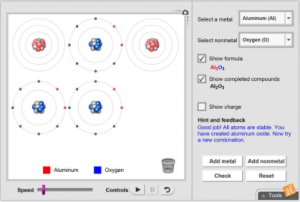- Home
- Resources
- Success Stories
- Success Story Article
Gizmos integrate technology, literacy, numeracy, and critical thinking into chemistry

Mr. Lawrence Akintokun teaches science at Forest Park High School in Clayton County Public Schools in Georgia. He began teaching with Gizmos in 2014, and has been the top high school Gizmos user in his district for the last two years.
Forest Park is a Title I high school and has “a population of 1850 students (46% African American, 40% Hispanic, 8% Asian and 6% other).” He teaches all grade levels. “The school has a computer cart that the students can make use of during and after school.” Students also use Gizmos on their cell phones.
Mr. Akintokun uses Gizmos “to introduce concepts in AP chemistry, especially titration, after the theoretical discussions before the real hands-on activities, and also to strengthen the mastery of concepts. I love Gizmos and am very comfortable using them in my classroom.” Gizmos work well with the Georgia Standard of Excellence (Georgia’s new science standards). “The fact that I could edit the worksheets to suit my students need was a great advantage. My students are always looking forward to Friday for the Gizmos experience.”
Most of his students are visual learners. “Teaching topics like bonding in general chemistry and titration in AP Chemistry with Gizmos allows students to have first-hand experience before engaging in the hands-on activities during the lab. Gizmos allow me to integrate technology into the chemistry curriculum and put technology in the hands of students. Literacy across the curriculum, numeracy across the curriculum, and critical thinking are part of my county’s academic achievement plans, all of which using Gizmos has been able to address.”
To show how he uses Gizmos in his classroom, Mr. Akintokun shared his lesson plan for a Gizmo: Ionic bonds.
STANDARD: SC2. Obtain, evaluate, and communicate information about the chemical and physical properties of matter resulting from the ability of atoms to form bonds. Ask questions about chemical names to identify patterns in IUPAC nomenclature in order to predict chemical names for ionic (binary and ternary), acidic, and inorganic covalent compounds
LEARNING TARGET: Students should be able to write the cation and anion of elements when electron(s) are lost or gained, should be able to identify patterns in the transfer of electron between metals and non-metals, should be able to predict chemical formula and names for binary ionic compounds.
Prior Knowledge: Students have done ionic bond in class drawing models on paper.
Presentation: Gizmos are done every Friday
Step 1: Give the students the printed Ionic Bond worksheet from the Gizmo for the Bell ringer and prior knowledge. Worksheet should be completed before allowing the use of computer to complete the remaining assignment.
Step 2: Lead the students to use the simulations of sodium and chlorine in the Gizmo to transfer electron from sodium to chlorine and check the formula and charges for the students to see the charge on sodium and chlorine.
Step 3: Ask students to give reason for the charge (sodium developed a positive charge corresponding to the number of electron transfer, and chlorine developed a negative charge due to accepting 1 electron from sodium).
Step 4: Students use the computer to answer the remaining questions on the worksheet, while teacher assists any struggling students.
Step 5: Students take the assessment quiz at the end of class to check for mastery.
 Mr. Lawrence Akintokun has taught Chemistry and AP Chemistry for 4 years at Forest Park High School. He is a Certified Chemistry and Broad Field Science teacher with the state of Georgia, and also gifted endorsed. He has a Bachelor’s degree in teaching Chemistry from University of Ilorin-Nigeria in 1999, where he taught Chemistry for 7 years. He received his Master’s degree in Science Education, with a major in Chemistry, from Western Governors’ University, Utah in 2011.
Mr. Lawrence Akintokun has taught Chemistry and AP Chemistry for 4 years at Forest Park High School. He is a Certified Chemistry and Broad Field Science teacher with the state of Georgia, and also gifted endorsed. He has a Bachelor’s degree in teaching Chemistry from University of Ilorin-Nigeria in 1999, where he taught Chemistry for 7 years. He received his Master’s degree in Science Education, with a major in Chemistry, from Western Governors’ University, Utah in 2011.
Sign up to get the latest updates from ExploreLearning via occasional email.
